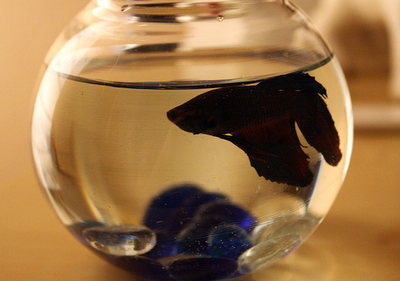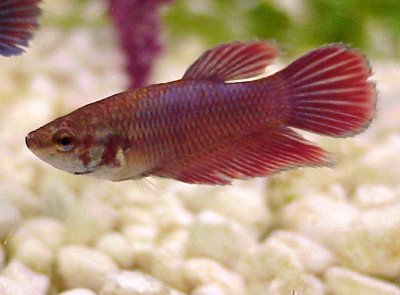The only thing cuter than critters are kids, so I thought why not combine the two? The first dedication goes out to Big W's daughter Phook! While more cute pictures of the Phookster can be found on her Momma's blog, here's one I snapped at Christmas:

I believe at this juncture Phook was chillin' with her Grandpa J and watching "The Wizard of Oz".
In addition to being a delightful two-year-old, Phookie has recently become an aquarist. Her betta's name is Steve-O. (Big W might have helped suggest the name!)

Betta splendens are common to southeast Asia, hence their nickname "Siamese Fighting Fish". Part of the Class Actinopterygii, or ray-finned fishes, bettas are in the gourami family, or Osphronemidae. Bettas, like other gourami, have developed a labyrinth organ in their heads that allow them to orally inhale oxygen from the surface of the water. This ability helps tropical species receive enough air from warm, oxygen-poor water. Bettas that cannot access the surface of their aquariums may drown!
The reputation of bettas as fighters is well-earned. Male fish will indeed fight to the death when they are enclosed close together. In the wild, the weaker fish will simply retreat to other territory. Wild bettas are actually gray-brown in color, with the males only gaining bright pigmentation during these battles. Breeders found a way to activate these bright reds, purples and blues in domesticated strains. Even the usually drab females have been bred to be colorful:

Even keeping females and males together in the same aquarium can be dicey; the boys are only nice during mating season! Male bettas can be placed in mixed aquariums, but ask a professional what kind of fish can handle these bullies.
Betta nooky involves the amorous couple spiraling around each other. During this "nuptial embrace" the female releases eggs, with the male fertilizing them. Then daddy fish creates a bubble nest for the eggs, and guards it for the three to four days it takes for the eggs to hatch! After the fry leave the nest though, they can be cannibalized by their parents.
As the last statement suggests, bettas are carnivores. In captivity they survive best with a protein-based food, but can be fed veggies cut into miniscule pieces. Bettas enjoy live food, too, such as mosquito larvae. Maybe Phook and her parents can collect some larvae this summer and feed them to Steve-O! But they better not put too many in there or the mosquitoes might hatch in their house....
One of the fancier bettas:

Well, big lovies to Phook, her little brother and the rest of the K family! I hope to meet Steve-O in person the next time I'm in the Motherland.
Bubblenest!
Wendell

1 comment:
Thank you for giving a shout-out to rad Phook and her pet! I am feeling especially happy he is still alive!
Post a Comment